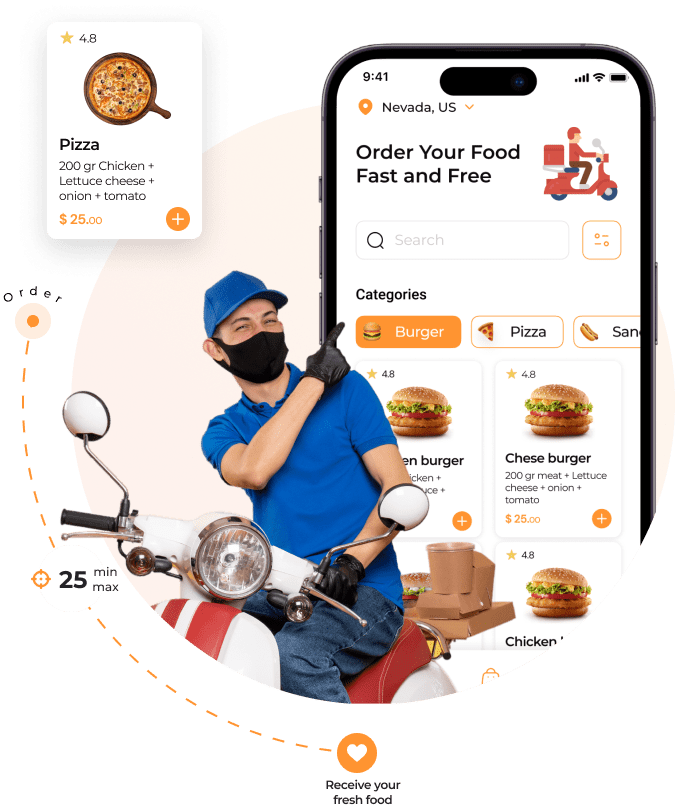Building a successful Postmates clone requires more than just replicating an existing app; it demands a deep understanding of the market, a focus on user experience, and a strategic approach to differentiation. This comprehensive guide will walk you through the essential steps and considerations for developing a competitive Postmates clone app that stands out in the crowded delivery service market.
1. Understand the Market and Your Target Audience
Before diving into development, it’s crucial to understand the market landscape and identify your target audience. Research the current trends in the delivery service industry and analyze competitors like Postmates, DoorDash, and Uber Eats. This will help you identify gaps in the market and opportunities for innovation.
Key Considerations:
- Market Trends: Look at emerging trends such as contactless delivery, eco-friendly practices, and hyperlocal services.
- Customer Preferences: Gather data on what customers value in delivery services—speed, reliability, variety, or cost.
- Competitive Analysis: Examine the strengths and weaknesses of existing delivery apps to identify opportunities for your clone to stand out.
2. Define Core Features and Functionality
A successful Postmates clone should include a set of core features that cater to both users and service providers. These features should be carefully designed to ensure a seamless and intuitive user experience.
Essential Features:
- User Interface (UI): Design an intuitive UI for both customers and delivery personnel. Ensure that navigation is straightforward and user-friendly.
- Real-Time Tracking: Implement GPS integration to provide real-time tracking of deliveries.
- Order Management: Allow users to place, track, and manage orders easily. Include options for customizing orders and managing payment methods.
- Driver App: Develop a separate app for delivery personnel with features such as order notifications, route optimization, and earnings tracking.
- Admin Panel: Create an admin dashboard to manage users, track orders, analyze data, and handle customer support.
3. Focus on Technology Stack and Development
Choosing the right technology stack is crucial for building a robust and scalable Postmates clone. Your technology choices will impact the app’s performance, scalability, and security.
Technology Stack Considerations:
- Frontend Development: Use frameworks like React Native or Flutter for cross-platform compatibility. Ensure that the app is responsive and performs well on both iOS and Android devices.
- Backend Development: Opt for a reliable backend framework like Node.js or Django. Ensure that your backend can handle high traffic and provides secure data management.
- Database: Choose a scalable database solution such as PostgreSQL, MongoDB, or Firebase Realtime Database. Ensure that it can handle large volumes of data and provide quick access.
- APIs and Integrations: Integrate third-party APIs for payment processing (e.g., Stripe, PayPal), maps and location services (e.g., Google Maps), and communication (e.g., Twilio for SMS notifications).
4. Design an Intuitive User Experience
User experience (UX) plays a crucial role in the success of your Postmates clone. A well-designed UX will keep users engaged and encourage them to return.
UX Design Tips:
- Simplify Navigation: Ensure that users can easily navigate through the app with minimal steps. A clean and simple design can enhance usability.
- Optimize Loading Times: Minimize loading times to ensure a smooth and efficient user experience. Optimize images and use caching where appropriate.
- Personalization: Offer personalized recommendations based on user preferences and order history. This can enhance user satisfaction and increase order frequency.
5. Implement Effective Marketing and User Acquisition Strategies
Building the app is just the beginning. To achieve success, you need a solid marketing strategy to attract users and drive growth.
Marketing Strategies:
- Social Media Marketing: Utilize social media platforms to promote your app. Create engaging content and run targeted ad campaigns to reach your audience.
- Influencer Partnerships: Collaborate with influencers in the food and delivery niche to reach a wider audience.
- Referral Programs: Implement referral programs to incentivize users to invite friends and family to use the app.
- Local SEO: Optimize your app’s online presence for local search queries. This can help you attract users from specific geographic areas.
6. Ensure Compliance and Security
Compliance with legal regulations and ensuring data security are critical for any delivery app. Make sure your Postmates clone adheres to relevant laws and provides a secure environment for users and service providers.
Compliance and Security Measures:
- Data Protection: Implement encryption and secure data storage practices to protect user information.
- Payment Security: Ensure that payment transactions are secure and comply with PCI DSS standards.
- Legal Compliance: Familiarize yourself with local regulations regarding delivery services, labor laws for drivers, and data privacy laws such as GDPR or CCPA.
7. Launch and Iterate
Once your Postmates clone is developed, it’s time to launch and gather user feedback. A successful launch is just the beginning; continuous improvement based on user feedback and performance metrics is essential for long-term success.
Post-Launch Activities:
- Beta Testing: Conduct beta testing to identify and fix any issues before the full launch. Gather feedback from a small group of users to make necessary improvements.
- Monitor Performance: Use analytics tools to monitor app performance, user behavior, and order metrics. This data can help you make informed decisions for future updates.
- Regular Updates: Continuously update your app with new features, improvements, and bug fixes. Stay responsive to user feedback and market changes.
8. Consider Advanced Features for Differentiation
To further differentiate your Postmates clone from competitors, consider adding advanced features that enhance user experience and provide additional value.
Advanced Features:
- AI-Powered Recommendations: Use AI to provide personalized recommendations and predictive analytics for users and delivery partners.
- Subscription Models: Offer subscription plans for frequent users to access benefits like free delivery or discounts.
- In-App Chat: Implement in-app messaging to facilitate communication between users and delivery personnel.
- Loyalty Programs: Create loyalty programs to reward repeat customers and encourage long-term engagement.
Conclusion
Building a successful Postmates clone involves careful planning, strategic development, and ongoing optimization. By understanding the market, defining essential features, focusing on technology, and implementing effective marketing strategies, you can create



